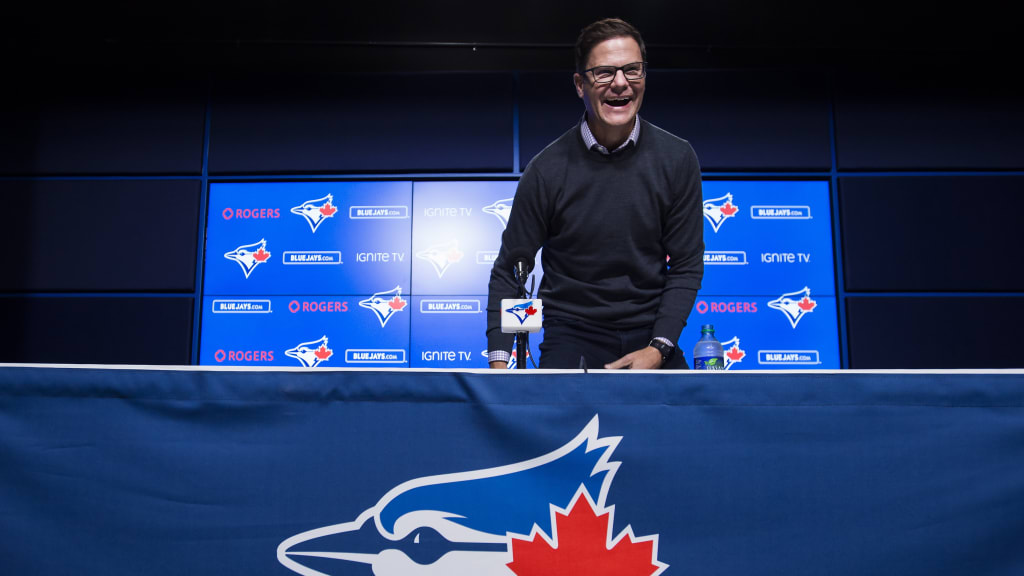
The Blue Jays’ brief 2020 postseason run is expected to be the first chapter of something much bigger, with a young core and payroll flexibility both working in the club's favor long term.
With lessons learned after their 32-28 season and loss to the Rays in the Wild Card Series, the Blue Jays enter this offseason with an opportunity to shop at each tier of the market, both in free agency and via trade, given that their prospect pool that remains strong despite so many promotions this past year.
Looking ahead to what could be a busy offseason, here are the names and dates to know:
Which players are free agents?
Position players: INF Joe Panik, INF Jonathan Villar
Pitchers: LHP Robbie Ray, RHP Matt Shoemaker, RHP Taijuan Walker, RHP Ken Giles, RHP Anthony Bass
This group shows how Toronto's roster is built, with a young core of controllable position talent and pitchers who are more established. That’s also why you can expect the Blue Jays to be more involved in the pitching market this offseason.
Matt Shoemaker fits the club’s needs and has established himself as a leader of the Blue Jays despite battling injuries, while both Taijuan Walker and Robbie Ray appeal to the Blue Jays at the right price. Besides, there’s a reason that general manager Ross Atkins and this front office targeted each of those arms, specifically, ahead of the 2020 Trade Deadline.
Did any of them receive qualifying offers?
None of the Blue Jays’ free agents received a qualifying offer from the club. Closer Ken Giles may have been the likeliest candidate if he’d pitched a full, healthy and dominant season, but Giles recently underwent Tommy John surgery and is expected to miss the 2021 season.
Qualifying offers, valued this offseason at $18.9 million, had to be extended to players by Sunday at 5 p.m. ET.
Who might be non-tender candidates?
Travis Shaw is entering his final arbitration year after earning $4.158 million in his first year with the Blue Jays, when he posted a .239 average and .717 OPS. The Blue Jays do need a third baseman to bridge the gap to the next wave of top prospects Jordan Groshans and Austin Martin, but they may seek an upgrade over Shaw.
Elsewhere, Ross Stripling is entering Year 2 of arbitration and looks like a valuable, flexible roster piece. Reliever A.J. Cole is also in his arbitration years, but he should be an attractive option to keep around on a small raise from his minimum salary in 2020. Outfielder Teoscar Hernández is entering arbitration, too, and after his breakout 2020 season, there could be some big paydays in his future.
All clubs will need to make decisions on tendering contracts to arbitration-eligible players by Dec. 2.
Will the Blue Jays extend any of their core players?
From Hernández to Bo Bichette, Cavan Biggio and Vladimir Guerrero Jr., the Blue Jays have plenty of options for early contract extensions. Such deals for young players are becoming more common, offering clubs both payroll clarity in the coming years and giving them added seasons of a player’s prime, but it has to work for both sides.
Club president Mark Shapiro has talked in the past about finding a sweet spot where both the team and player shares a level of eagerness as well as a share of the risk involved in these deals. With Cleveland, Shapiro was involved in early extensions to players like Corey Kluber, Jason Kipnis and Yan Gomes.
The Blue Jays will continue to discuss these possibilities, though there’s been no noticeable movement or traction on any front. Keep this in mind, though, as getting some deals done early would help the Blue Jays avoid several young players reaching their expensive arbitration years at the same time down the road.
Who needs to be added to the 40-man roster for Rule 5 Draft protection?
Prospects eligible for the Rule 5 Draft this coming offseason include: C Gabriel Moreno (No. 8 prospect), SS/2B Otto Lopez (No. 13), SS/3B Kevin Smith (No. 19), Josh Winckowski (No. 26), OF Chavez Young (No. 30), C Riley Adams, RHP Ty Tice, 2B Samad Taylor and 1B/OF Ryan Noda. Outfielders Joshua Palacios and Forrest Wall will also be eligible for the Rule 5 Draft again after going unselected in 2019.
The Blue Jays are staring at a good problem here, with some players they’d like to protect and a deep roster they’ll need to make room on. Their departing free agents will help free up some space, but they’re also expected to be active in free agency and the trade market, so it won’t be simple. In theory, this could lead to the Blue Jays looking to deal some of their valuable 40-man roster depth instead of simply designating players for assignment.
How might that be resolved, and when does that need to be set?
These decisions need to be made by Nov. 20, and the Blue Jays will need to think long and hard about how they piece this puzzle together. Catcher Gabriel Moreno is highly regarded, but along with Danny Jansen, Alejandro Kirk and Reese McGuire, that would make four catchers on the 40-man roster. It’s doable, but not ideal.
From there, the Blue Jays will need to make some risk assessments. Young Lopez is plenty versatile, and he hit .324 in the Minors in 2019, but that was with Class A Lansing. Winckowski posted a 2.69 ERA between Lansing and Class A Advanced Dunedin that year, but is he close enough for a team to take a flier? Smith’s first-round shine has worn off, while Adams, a former third-rounder, could appeal to a team that thinks they can unlock even more power from his strong frame.
Keep Tice’s name in mind, too. A reliever won’t be given the same priority of a catcher or starter when it comes to the Blue Jays’ decisions, but if you’re a team in the Rule 5 Draft with open spots, Tice brings Triple-A experience with a high strikeout rate despite his 5-foot-9 frame.
What kind of help do they need and will they be active in free agency?
In terms of true needs, the Blue Jays will likely have a vacancy at third base. Bringing back Shaw is an option, and Atkins has floated the idea of Guerrero seeing a few reps there again in 2021, but that seems highly unlikely, as Guerrero is still struggling to get comfortable at first base. The club has prospects coming, but it needs third base to produce far better than it did in '20 over the next season or two.
There will be the usual bullpen additions, which the Blue Jays have done very well with when shopping at the bottom end of the market, but starting pitching remains a priority. It might not be the same type of starter that they chase this offseason, though.
Toronto has pitching depth. It’s never enough, but the club has a strong base of young arms to start with. It will continue to add to that, but the Blue Jays have a clear opportunity to swing big on a high-upside arm to complement Hyun Jin Ryu and Nate Pearson. There are many -- and cheaper -- ways to figure out their starter innings, so that might not be a major financial priority.
Uncertainties remain when it comes to Toronto’s 2021 payroll, but you could say that for most Major League teams after the shortened 2020 season. The Blue Jays’ front office will meet with the ownership group in mid-November to present a budget proposal, but Shapiro is optimistic that his club will have the freedom to remain aggressive.
“The reality of the pandemic clearly changes the dynamic of our revenues,” Shapiro said. “However, there has been consistent support from our ownership and consistent encouragement that we continue to progress in our plan, that we continue to move forward. That was evident with [signing] Ryu, that was evident at the Trade Deadline in a very truncated season.”
Are any prospects ready to fill these needs?
Toronto's farm system has reached the point where there could be a one-year gap before the next major wave of arrivals, and that's fine. Big arms like Simeon Woods Richardson (No. 4 prospect), Alek Manoah (No. 5) and Adam Kloffenstein (No. 10) still need some time, and the same goes for position players like Austin Martin (No. 2) and Jordan Groshans (No. 3).
Granted, Kirk's sudden rise shows that the Blue Jays are willing to be aggressive when necessary, but that won't be Plan A by any means. Further down, No. 18 prospect Patrick Murphy could help in the bullpen or start in Triple-A as a starter, while No. 20 prospect Julian Merryweather will enter 2021 as a starter, Atkins said. No. 28 prospect T.J. Zeuch is also likely to open as a rotation depth piece from Triple-A, as the 2016 first-rounder made a good impression over three outings in '20.


